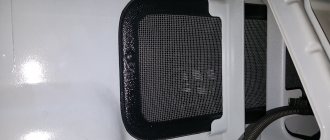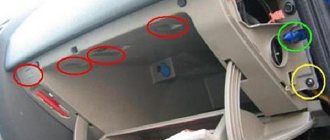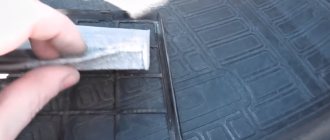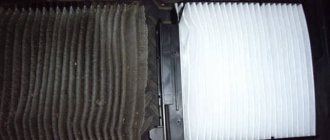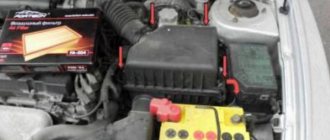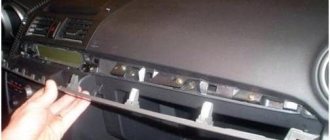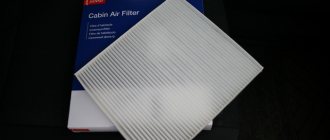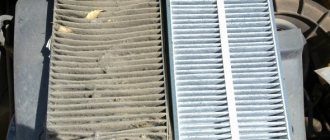May 18, 2020 Lada.Online 44 673 4
According to the maintenance regulations, the cabin air filter on Lada Vesta and XRAY must be replaced once every 15,000 km. For proper operation of the interior ventilation and air conditioning system, the manufacturer recommends promptly changing the filter element. Let's figure out which cabin filter is best to buy.
Where is the cabin filter of Lada Vesta
In Lada Vesta (SV Cross), the cabin filter is installed on the passenger side next to the heater under the instrument panel.
This arrangement optimizes the use of limited interior space, but complicates the process of replacing an element.
The cheapest configurations do not provide for its use; the inlet hole is closed with a special plug.
Replacement frequency
The maintenance schedule for Lada Vesta vehicles recommends changing the cabin filter every 15 thousand kilometers. In fact, this parameter is almost never maintained.
Causes:
- different quality of filters from different manufacturers;
- uneven operating conditions.
Based on the actual clogging values, experienced mechanics advise changing the element when preparing the car for the summer season.
It is better to use a carbon filter if the machine is operated in urban conditions - the air is saturated with smog and various harmful chemical compounds.
If the car is for a village or small settlements, then it is enough to install cheap filters to capture particulate matter.
When should you change?
The frequency recommended by manufacturers does not always “work”; the reasons for this phenomenon will be indicated below in this article.
But there are several practical tips that will help you avoid missing the time to replace the cabin filter.
Signs indicating loss of functionality of an element:
- the intensity of the air flow from the stove decreases when the external air intake is turned on;
- the time it takes to warm up the cabin to a comfortable temperature increases;
- the stove engine runs for a long time and with a critical load;
- the windshield fogs up on the inside or takes a long time to thaw;
- there is a noticeable increase in the amount of dust on the panel elements;
- There are unpleasant odors in the car.
The presence of one of the listed signs indicates that the filter element is clogged and needs to be replaced.
Generator: Valeo brand, made in Türkiye
The generator of the same French brand Valeo, but already made in Turkey, confused us at first - instead of the usual orange transformer varnish, the windings are covered with protection that is not uniform in color. However, as they say, “the speed should not be affected.” But we consider the fact that the terminals from the winding were not soldered, but simply crimped, to be a disadvantage. Not durable.
In addition, dismantling the component (replacement) is extremely difficult due to its location. The generator is clamped by the air conditioning compressor from below and its tubes - from the end and from the top, and from the belt drive side, as well as the tension roller, by the wall of the engine compartment. As a result, when replacing the generator, you will have to remove the air conditioning compressor (if there is one, of course).
Three more Valeo components found: starter (Poland), release bearing and climate control unit (Czech Republic). The French company is one of the world's main manufacturers and suppliers of components for car factories, including, of course, fellow countrymen from Renault, from whom it migrated to AvtoVAZ.
Which cabin filter should I install?
Lada Vesa cars are factory equipped with elements with catalog number 272773016R.
The filter element is made of non-woven fiber and is capable of trapping solid particles with a diameter of ≤ 1 µm.
Original products are manufactured by Renault, the licensed manufacturer is Mann Filter.
Cheaper analogues are produced by the following companies:
- Pilenga (Pilenga FA-P0443);
- BIG FILTER (GB-9978);
- Finwhale (Finwhale AS433 and charcoal variant Finwhale AS433C).
Domestic manufacturers are also engaged in the production of such elements:
- Nevsky filter (NF6433 and carbon NF6433C);
- SibTEK (AC 43003 and AC 0443003 coal version);
- TSN Citron (coal TSN 97888K and dust TSN 97888).
The problem with domestic products is the discrepancy between the declared indicators and the actual values. The reason is low labor discipline and outdated technologies.
The final choice depends on the desires of car owners, but experienced mechanics strongly recommend not using cheap unlicensed substitutes.
A production license is issued by the original company after a rigorous check of all technological processes and materials used for compliance with current requirements; not everyone can obtain it.
The difference in cost is not worth the lost time and deterioration in air quality in the cabin. You should also remember that the lower the quality, the more often you have to make a replacement.
What to prefer?
VAZ manufacturers equip vehicles with a filter component model such as Mann. The catalog number is recorded in the technical documentation.
It is not necessary to use the same model for replacement. After all, a huge number of products are put up for sale that are suitable for completing the Lada vesta interior. So, you can use elements from brands such as BIG, Ekofil, Nevsky. The cost of such products varies.
When selecting a filter, the article number is checked. Taking it into account eliminates the difficulties and problems associated with selection and installation.
In order for the replacement of the cabin filter to be successful, the features and recommendations of specialists, which are recorded in the technical documentation, are studied.
Filter characteristics
The linear dimensions of the Lada Vesta cabin filter correspond to the seat: height 35 mm, length 216 mm, width 200 mm.
Important. The filter has a rectangular shape, it must be installed taking this parameter into account.
The folds are vertical, with the exception of FILTRON K1321 with horizontal corrugation. This design feature has changed the location of the rigid slats; they are vertical rather than horizontal.
Let's consider the process of replacing the filter element without removing and with removing the glove compartment.
Preparing tools and supplies
Naturally, at the same time as changing the filter element, the oil is also changed, otherwise it would instantly become dirty. But for different modifications of Lada Vesta, different volumes will be required to fill the lubrication system:
- 1.6 l. (11189) - 3.6 l. oils;
- 1.6 l. (21189) - 4.4 l. for manual transmission, 3.2 l. for automatic transmission;
- 1.8 l. (21179) - 4.2 l.;
- 1.6 l. N4M - 4.3 l.
The work process itself must be performed with protective gloves, since we are talking about a chemically active compound. Before replacement, the car engine is warmed up - this allows you to better get rid of the remaining old oil and better clean the entire system as a whole. Accordingly, this will extend the life of the car engine.
The following is a complete list of the necessary tools and consumables that will be needed when performing the work:
- new filter element (either original or analogues from trusted manufacturers);
- container into which the waste liquid will be drained;
- hex wrench;
- set of keys with socket and cap included;
- a special puller key for unscrewing the filter element;
- stub;
- several dry rags;
- protective gloves or gloves.
Replacement with glove box removal
This method takes a little more time, but allows you to better control your actions and the position of the element.
It is recommended for beginners who have no experience in performing such activities and cannot determine by force whether the filter is installed correctly.
Before replacing the element, the right floor covering and glove compartment must be removed.
The process consists of several operations.
- The screw securing the tunnel lining to the floor is unscrewed (T-20 key). To make work easier, it is sometimes necessary to clean the splines from dirt.
- The facing panel is removed. It is held in place by three latches; you need to find their location, press the latches and carefully pry the panel into the slot. You should work carefully, especially on old cars - plastic's intermolecular bonds weaken over time, it loses its plasticity and can easily break off. This is a problem, rattling will appear, you will have to come up with new methods of fastening. There are three latches on the panel; if desired, you can slightly reduce the height of the hooks to facilitate repeated dismantling, but this must be done wisely. It is better to use a heated metal object and constantly check the grip. This method allows, if necessary, to return the original geometry of the elements.
- In the same way, carefully remove the side of the dashboard on the right side. Use a slotted screwdriver or a knife to locate the clamps and press the protruding teeth one by one.
- The glove compartment is removed; to do this, unscrew the holding screws with a T-20 bat. It is necessary to remove the lower left and right screws and the three upper ones.
1 of 4— +
1.
2.
3.
4.
- The backlight is disconnected. The box is moved back a little and the connector is removed.
- The filter cover is removed. It is secured with two plastic clips; the lower part of the element slides in grooves along the housing guides and is removed.
- The air filter is removed. If it is tight, then to facilitate the process you need to perform oscillatory movements, and if necessary, compress it a little at the top. It is advisable to pay attention to the condition of the filter, taking into account the operating conditions of the vehicle. This will help you more accurately determine the time of the next element replacement.
- The location of the filter is thoroughly cleaned of dust using a vacuum cleaner.
The installation process is done in reverse order. Before starting work, you need to check the dimensions of the element and pay attention to the position of the arrow. It indicates the direction of air movement and should face the cabin.
Functions that a high-quality cabin filter should perform
This list includes:
- remove the smallest solid particles;
- prevent allergenic plant pollen from entering the cabin;
- captures chemical compounds of exhaust gases (oxides of nitrogen, carbon, sulfur, compounds of heavy metals, etc.);
- minimizes the harmful effects of low-quality washer fluids (solvent vapors, alcohols).
But you shouldn’t think that cabin filters only improve the microclimate in the cabin; their use solves several other important problems.
- Reduces the number of interior cleanings. While removing dust from plastic and leather interior elements is not difficult, cleaning fabric elements is a rather complex and time-consuming procedure.
- Increases the reliability of all rotating pairs. This refers to electric motors that drive heating, air conditioning, and other units located in the cabin. Dust has abrasive properties and significantly increases the wear of rubbing parts.
The capabilities of filters depend on their design. The simplest and cheapest ones purify the air only from solid particles. The most effective ones for complex cleaning have, in addition to paper elements, activated carbon fillers.
Regulatory requirements for the characteristics of the cabin filter Lada Vesta
To ensure high-quality and safe operation, the cabin filter of Lada Vesta and other cars must meet the following characteristics:
- trap at least 99% of solid particles of specified sizes;
- not to deform or change linear dimensions under the influence of moisture;
- do not support open combustion;
- have a large filtration area with the smallest possible dimensions;
- securely fixed in place.
During product testing, the following parameters are monitored:
- dust retention ability;
- efficiency up to maximum pressure drop;
- dust holding capacity;
- frontal air flow speed;
- diameter of passing particles;
- secondary entrainment of dust.
Some irresponsible companies do not pay enough attention to monitoring technical parameters, which has a negative impact on the quality of air in the cabin.
Selecting consumables
There is an opinion that different modifications of the Lada Vesta, which is equipped with 1.6 and 1.8 liter engines, require different cabin air filters. This is a misconception that does not correspond to reality.
The current original consumable for the Lada Vesta model is a product manufactured by Mann with the index or catalog number CU22011. Such a filter will cost the motorist at least 850 rubles. Moreover, this is exactly what they will ask for for a regular paper filter based on synthetic fibers.
There is another filter, which is also considered the original. It is in many ways similar to the previous one, and the difference between them is minimal. Although the price is almost 2 times less. This is also a consumable from Mann with number 272773016R. It costs from 400 rubles and is suitable for Vesta and the X-Ray model.
But it is not at all necessary to buy the original, as almost every car enthusiast knows very well. Among the cheapest analogues, we can note the salon GB9978 from Big Filter or FAP0443 from the Pilenga brand. Big Filter has a carbon analogue of the named model, where the sign C is added at the end of the index.
